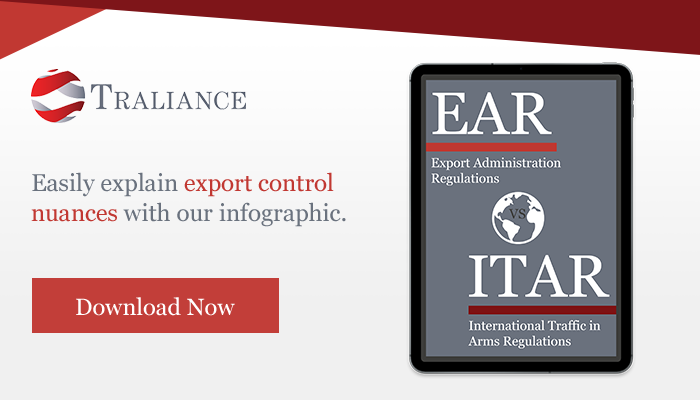
EAR vs. ITAR Compliance: Can You Name 5 Differences?
Compliance to the Export Administration Regulations (EAR) and the International Traffic in Arms Regulations (ITAR) are rooted in the same concept behind many government regulations: Sometimes you need to ask the government for permission before doing something. Especially if that “something” can potentially endanger others…even if your particular activity means no harm. The tricky part is figuring out when you need to ask for permission.
#1: Who’s in Charge?
While both the EAR and ITAR are key U.S. export controls regulations, they are administered by two different departments. Determining the commodity jurisdiction of your intended activity is one of the first steps in determining your export compliance requirements. Sometimes both departments have jurisdiction over different parts of the same research project at your university or company.
Department of Commerce
Bureau of Industry and Security (BIS)
Export Administration Regulations (EAR)
Department of State
Directorate of Defense Trade Controls (DDTC)
International Traffic in Arms Regulations (ITAR)
As you’ll see below, the EAR and ITAR differ in many ways. Focusing on the wrong commodity jurisdiction can lead to significant mis-steps in your export compliance program.
#2: Dual-Use?
The EAR covers both dual-use and pure military items. “Dual-use” simply means that there is a civilian and military use for the item. A dual-use item is still dual-use even if your company or university is not using it or developing it for military applications. Meanwhile, the ITAR covers purely military and defense-related items that are more sensitive to national security.
#3: Which Control List?
The framework behind the lists of controlled “items” is quite different under the EAR and ITAR. Yes, both sets of regulations have their own control list. Remember that it’s not just tangible goods on these lists – certain sensitive technical data, software, and services are listed, too. Unfortunately, these lists are more like reference guides rather than lists. When I think of a list, I think of a shopping list. In that regard, the lists are like complicated shopping lists. Rather than listing “shirt”…a description would be “striped blue long-sleeve button-down shirt with a rounded collar that is machine-washable and made of 50% or more cotton.” These lists required careful and detailed analysis.
Export Administration Regulations
Commerce Control List (CCL)
Organized by Export Control Classification Numbers (which indicate a Category, Group, Reason for Control, and Serial Number)
International Traffic in Arms Regulations
United States Munitions List (USML)
Organized by Categories
With the prior Administration’s Export Control Reform and the current Administration’s USML to CCL Review Process, as well as the Export Control Reform Act of 2018, there are many changes happening with both lists. In fact, proposed changes were recently published for moving certain items from USML Category I, II, and III to the CCL.
#4: Use or Using?
While both the EAR and ITAR generally regulate access to export controlled items by individuals located in the U.S., there is a key difference. The EAR has a stated definition of “use” technology that is helpful to many universities. In other words, there is a high bar that needs to be met in order to possess or generate “use” technology.
Export Administration Regulations
“Use” technology is a defined word in the EAR that has 6 elements which must all be met. The elements generally relate to the installation and maintenance of an item. Using export controlled equipment does not necessarily mean that “use” technology has been shared with the user. Your researchers might only be using technology in the dictionary sense, rather than handling “use” technology. Misunderstanding this aspect of the regulations can lead to unnecessarily conservative compliance measures.
International Traffic in Arms Regulations
There is no parallel definition of “use” technology under the ITAR. The ITAR has a much higher bar for access by a foreign national individual located in the U.Ss. Requiring pre-authorization by DDTC is the norm, unless a specific exemption works in your favor. Check for requirements in advance!
#5: To Publish or Not to Publish?
While both the EAR and ITAR have a notion of public information being exempt from the regulations, important details vary between the two. One key difference is around pre-approval. Lack of awareness around this difference can quickly lead to unintentional violations in the university environment where publishing is a fundamental objective.
Export Administration Regulations
Pre-approval by BIS is not required to publish technology that would otherwise be subject to the EAR.
International Traffic in Arms Regulations
Pre-approval by an appropriate government agency is required to publish technology that would otherwise be subject to the ITAR. (Which exact agencies require more details and are case-specific.)
More Differences
Alas, there are more than just 5 differences. Another key difference is rooted in the Fundamental Research Exclusion (FRE) and nominal pre-publication reviews. Depending on how the Department of State settles on a final definition of the FRE in the ITAR, the difference can be vast and have significant implications for internal compliance programs. If the question about commodity jurisdiction (Department of State vs. Department of Commerce) has not been asked at your university…it’s wise to revisit some basics behind your compliance program. This is especially true if your researchers are interested in publishing their results.
Comments
Very interesting and useful information. Thanks Jennifer.
Well done!





Hi Jennifer,
This is a great recap of “export control basics” in a nutshell, which (at times), may not be so basic. Thanks so much for sharing your insight.
Have a good one!
Warm Regards, Lorry